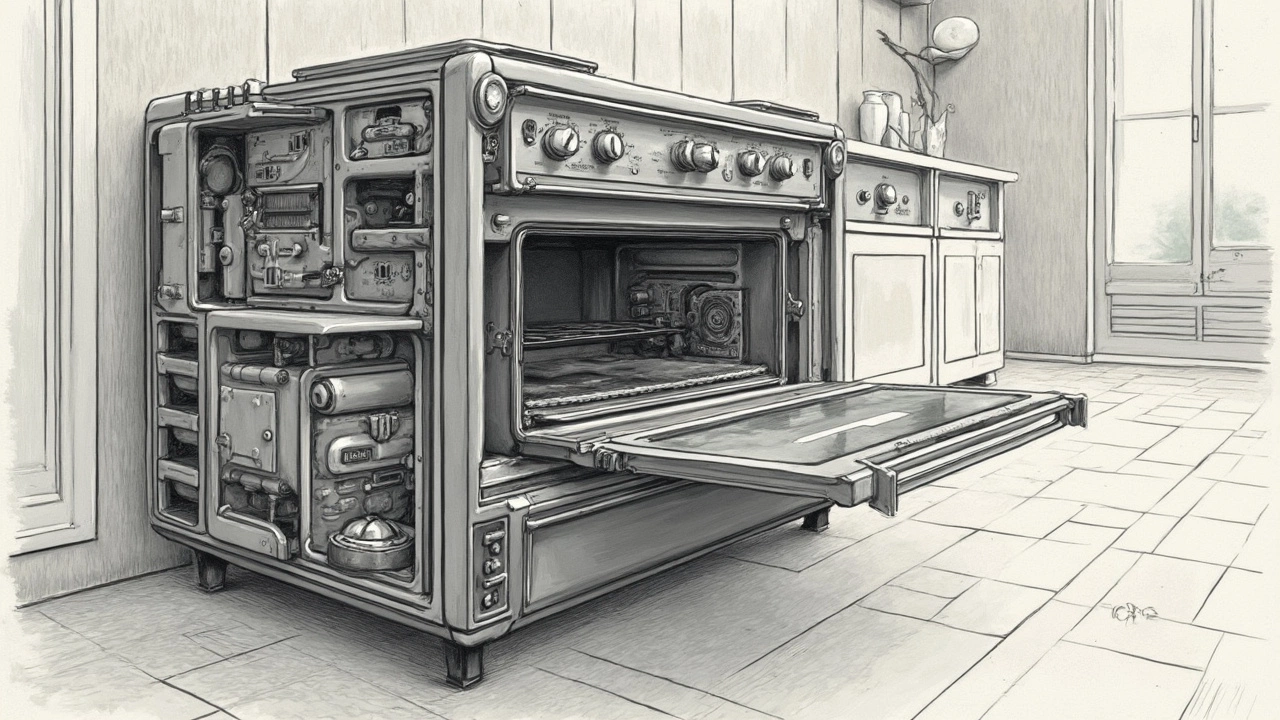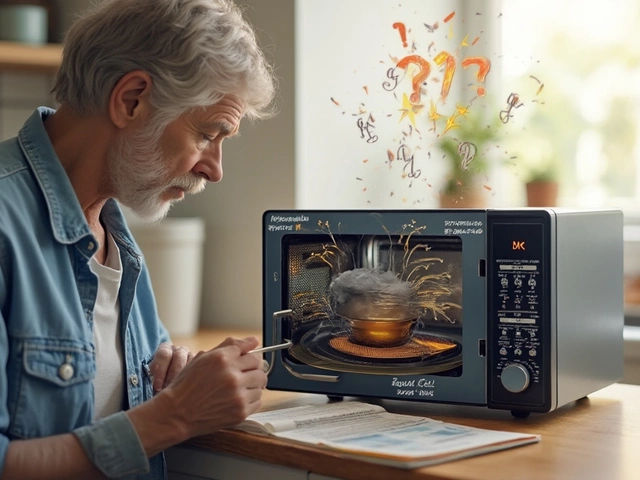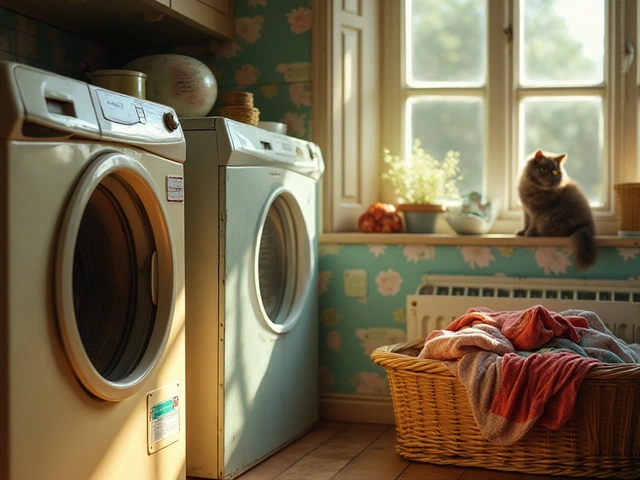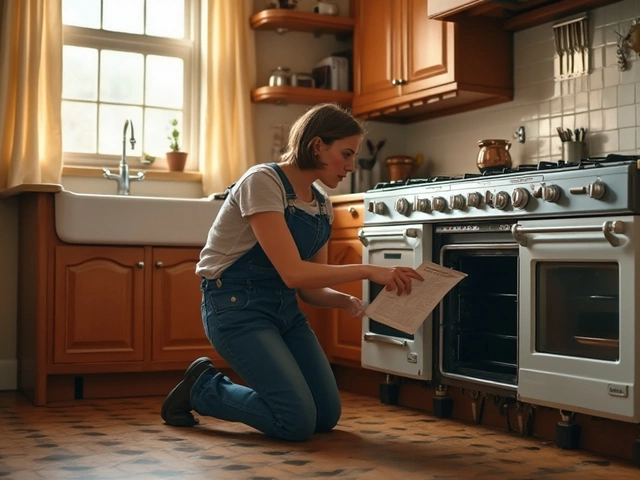So, your lasagna is prepped to perfection, but the oven's not playing its part. Annoying, right? Before you panic, let's figure out what's going on.
First off, let's tackle the basics that often get overlooked. Is your oven actually plugged in? Sometimes a loose plug or tripped breaker might be the only culprit. Head to your switchboard and make sure everything's in order. It might sound too simple, but it's often these tiny details that trip us up.
If the power's good, the next suspect is the heating element. These are the parts that do the actual heating, so if they're not working, neither will your oven. Take a peek inside the oven. Notice any visible damage or breaks? That right there could be your issue.
- Check the Power Supply
- Heating Elements: What to Look For
- Thermostat Troubles
- The Control Board Dilemma
- Professional vs. DIY Repair
- Prevention and Care Tips
Check the Power Supply
Feeling frustrated because there's no heat in your electric oven? Before thinking of more complicated reasons, ensure your oven is actually receiving power. It's simple but often ignored. Here’s how you do it.
Check the Plug and Outlet
First, pull your oven away from the wall (ask for help if it's heavy). Ensure it's firmly plugged into the outlet. If it’s slightly out or not plugged in, you’ve likely found the cause of your woes.
Ensure the power cord isn’t damaged or frayed. If it is, unplug immediately and consider calling in a professional to replace it.
Check Your Circuit Breaker
If the plug's good, go straight to the circuit breaker. Sometimes, an overloaded circuit causes the breaker to trip. Head to your household electrical panel and see if the breaker for the kitchen or oven is flipped. If it is, flip it back on, and see if the power returns. Keep an eye on it to ensure it doesn’t trip again—repeated trips can mean a deeper electrical problem.
Test the Outlet
If the breaker wasn’t tripped, you might have a faulty outlet. Use a multimeter to check if there's voltage coming through. This nifty tool can save you a world of headaches by showing whether the outlet works.
Consider Voltage Needs
Remember, most ovens need a 240V outlet. If your oven's connected to a lower voltage outlet, it's not going to work properly. You might spot these odd outlets if you’ve recently moved or had electricity work done. Getting an electrician to sort it can be worth every penny.
Regularly checking these small details can save you from bigger, more costly appliance repair problems in the future. Your trusty electric oven will thank you for it!
Heating Elements: What to Look For
Alright, let's zero in on those heating elements, the unsung heroes of any electric oven. If your oven's playing it cold, these could be the culprits.
Identifying the Heating Elements
Inside every electric oven, there are usually two main heating elements—one at the top (broil element) and one at the bottom (bake element). When working correctly, these glow red-hot. If they don't, you might have your mystery solved.
Visual Inspection
Start by switching off the power to your oven. Once it's safe, open up and take a good look. Visible cracks or blistering on the elements are a clear sign they're fried. Even if you don't see obvious damage, a dull, non-glowing element when the oven is switched on often means it's not working at full power.
Testing with a Multimeter
Things getting technical? Consider bonding with your multimeter. Set it to the lowest resistance setting and test the element's terminals for continuity. You're looking for a reading between 20 and 40 ohms. A reading that’s way off means it's time for a replacement.
Replacing the Heating Elements
- Start by powering down the oven. Safety first!
- Unscrew the elements carefully. A handy tip here: Have a container ready for those screws. They love going missing.
- Detach the wires, remembering where they go. Snap a pic if you need, future-you will thank you.
- Attach the new element, connect the wires, and screw everything back together.
If DIY isn't your style or if the troubleshooting feels out of your league, don't hesitate to call in a professional. After all, it's better to be safe than dealing with even larger repair costs down the track.
And there you go, armed with knowledge about oven troubleshooting that's sure to restore that oven to its former glory. Say goodbye to cold meals!
Thermostat Troubles
When your electric oven isn't heating properly, an often-especially problematic part is the thermostat. This small yet crucial component regulates the oven's temperature. If it's on the fritz, you're looking at some culinary chaos.
How does a thermostat cause havoc? Well, if it's misreading the oven's temperature, it won't signal the heating elements to heat up or shut off at the right times. So, your oven's internal climate is all out of whack. To figure out if the thermostat is a problem, you might need a multimeter - that's a nifty tool that checks electrical connections, to see if your thermostat has gone rogue.
John Smith, a renowned appliance repair expert, advises, "Regular operation of an oven's thermostat is critical for reliable cooking results. A consistently faulty thermostat can drastically affect both cooking performance and energy consumption."
Signs Your Thermostat Is Acting Up
- Inconsistent temperature: If your oven's temperature doesn't match the setting, that's a massive red flag.
- No heat at all: The oven doesn't heat despite being on. Classic thermostat failure.
- Error codes: Some ovens will flash error codes specific to thermostat issues.
Fixing the Issue
For starters, a quick recalibration might be the solution. Many oven troubleshooting guides include steps for recalibrating the thermostat through the control panel. However, if recalibration doesn't work, it may be time to replace it.
If you feel squeamish about fiddling with your oven's guts, consider professional help. The last thing you want is a DIY repair leading to a void warranty or worse, injury! Sometimes spending a bit on expert repair is the best move, especially if you suspect deeper electrical issues.

The Control Board Dilemma
Now, we’re getting to the brains of your oven: the control board. Think of it as the oven's command center. It manages everything from temperatures to timers. When this little hub goes haywire, it can leave you with an oven that's as cold as the fridge.
First off, what could go wrong? Well, like any electronic part, it’s not immune to wear and tear. Power surges or even just plain aging can cause the control board to falter. When this happens, you might end up with no heat, intermittent heat, or an oven stuck in preheat. It's like your oven’s trying to sabotage your next big dinner party.
Spotting the Symptoms
Not sure if your control board is the guilty party? Here’s how to tell:
- Unresponsive controls or display
- Inconsistent oven temperatures
- Error messages on the display
- Lack of response when you press the buttons
Does one of these sound familiar? You might have a control board issue on your hands.
DIY: A Risky Business?
So you’re thinking, "I can fix this." Well, proceed with caution. Messing with electronics can be tricky. Before diving in, ensure the power’s off. Nothing ruins a day like a shocking experience, right?
If you’re tech-savvy, you might try a hard reset. Unplug the oven, wait a minute, and plug it back in, hoping it’s just a hiccup. If that doesn’t work and you’re still keen to DIY, ordering a replacement board might be your next move.
When to Call the Pros
If the thought of circuit boards and wiring isn’t your thing, calling a professional might be the way to go. A certified technician can diagnose and fix control board issues quickly, saving your sanity and maybe even your cooking schedule.
Remember, investing in maintenance and repairs today can save costly replacements tomorrow, not to mention ensuring you don’t have to resort to takeout on Christmas Eve!
Professional vs. DIY Repair
Deciding between handling that oven repair yourself or calling in a pro can be tricky. Let's break down what you should consider when you're stuck with an electric oven repair.
When DIY Makes Sense
Tackling a repair yourself can be satisfying and kinder on your wallet. If it's something straightforward, like a simple oven troubleshooting issue—say, checking a blown fuse, replacing an element, or cleaning the contacts to your control board—it might be DIY-friendly. Just make sure you unplug the oven before diving in. Safety first, always!
There are heaps of online tutorials and guides. For some issues, all you need is a basic tool kit and a bit of patience.
Time to Call the Pros
However, when things get complex, calling a professional is often the way to go. If you're unsure of what you’re looking at or dealing with electrical components that could lead to more damage, it’s best to step back. Professionals bring a level of expertise that can quickly diagnose elusive problems, like a faulty control board or a thermostat gone rogue.
Thinking of time? Pros typically fix issues faster since they've seen it all. Plus, they usually offer guarantees on their work, meaning you’re safer from recurring problems.
A Quick Cost vs. Risk Summary
| Repair Type | Estimated Cost Range | Risk Level |
|---|---|---|
| DIY Simple Fixes | $0 - $50 | Low |
| DIY Complex Repairs | $50 - $100 (tools/parts) | Medium to High |
| Professional Repairs | $150 - $300 | Low |
At the end of the day, weigh up the potential cost savings against the risks of going it alone. If you're ever in doubt, it's better to grab a coffee and call the repair folks than to risk turning a problem into an even bigger headache!
Prevention and Care Tips
Keeping your electric oven in tip-top shape isn't rocket science. A little regular maintenance goes a long way in preventing heating issues down the line. Let's dive into some practical tips.
Regular Cleaning
A clean oven is a happy oven. After using it, let it cool down, and give it a quick wipe. Pay special attention to the heating elements; grease and grime can build up and impact their performance.
- Remove spills immediately before they bake on and become tough to clean.
- Use a gentle cleaner designed for ovens and avoid abrasive tools that can scratch surfaces.
Check the Seals
An oven door that doesn't seal properly can make your oven less efficient, costing you time and energy. Inspect the gaskets regularly and replace them if they appear cracked or worn.
Keep an Eye on the Heating Elements
The heating elements should glow evenly when in action. Uneven heating, dark spots, or visible damage on the coils are signs they may need replacement.
Power Precautions
Make sure your oven is connected to a reliable power source. A power surge protector can prevent any unexpected electrical issues.
Schedule Regular Inspections
If your oven is starting to show signs of wear or has seen a lot of use, consider booking a professional inspection annually. It might sound like an expense, but it saves you more in the long run by catching small issues before they turn big.
By sticking to these easy tips, you can keep your meals sizzling hot and your electric oven running smoothly for years to come!





